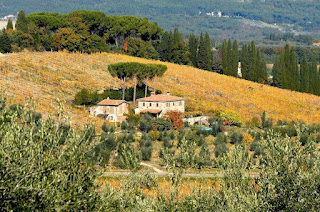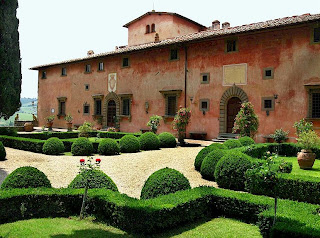- Village apartment or rural farmhouse ("villa")? For those who plan to dine out with plentiful wine accompanying their meals, it can make sense to choose accommodation within walking distance of restaurants, and that usually means in town or, if the place is small like Greve in Chianti, then right on the outskirts. Greve has real agriturismi within walking distance of the main piazza. But see the next point.
- Swimming pool or not? If you definitely want a pool, you'll need to stay in a rural area because only hotels have pools in town, and town hotels are very rare in Chianti in any case. Don't forget, however, that there are good public swimming pools in some towns, again notably in Greve in Chianti.
- Multi-unit accommodation or stand-alone farmhouse? Usually multi-unit vacation rentals are more economical if only because the swimming pool and possibly some other facilities, such as a barbeque, are shared. Some people also like the company. For others who prefer complete privacy and tranquility, having your own place to stay out in the country is the way to go.
- Do I need WiFi? More and more visitors to Chianti wish or need to have access to the internet during their vacation. In response, most of the places to stay in Chianti offer WiFi if it's technically possible. Not all of them specify this on their websites so be sure to ask. Truly remote farmhouses will probably not have an ADSL line.
- Must the road be sealed? If you plan to stay outside of town, be prepared for at least some gravel roads. These "strade bianche" pose no special challenges and often lead to very picturesque sights - castles, romanesque churches, monasteries, ancient farmhouses and tower houses.
- Access to public transport? The most efficient way, time-wise, to visit the sights of Chianti is by car, either driving yourself or by hiring a driver-guide. Nevertheless, it is also possible to see many places by walking and by using public transport - almost always a bus, since there are no trains within the Chianti Classico part of Chianti. Many rural accommodations have a bus stop nearby but be sure to study and understand the bus time tables. See Chianti without a car.
- Near Florence or near Sienna? This depends almost solely on whether or not you will have your own car. From Castellina southwards, the buses run to Sienna. From Panzano northwards, the buses run to Florence. Both of these famous art cities, located at the northerly and southerly boundaries of the Chianti Classico area respectively, are readily accessible by car from anywhere in Chianti in usually less than an hour.
More about what to expect from your Chianti vacation rental accommodation.
Author: Anna Maria Baldini




